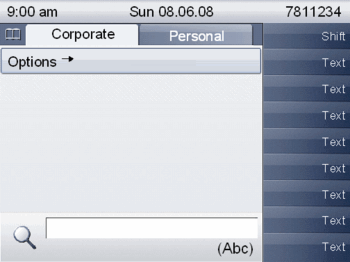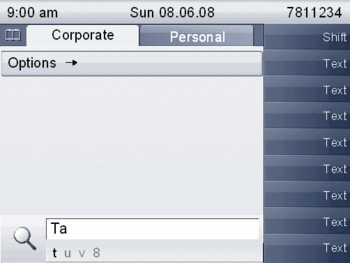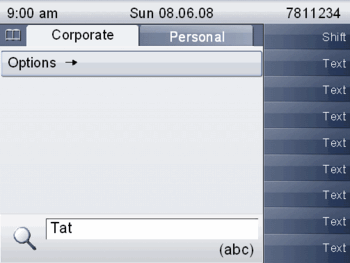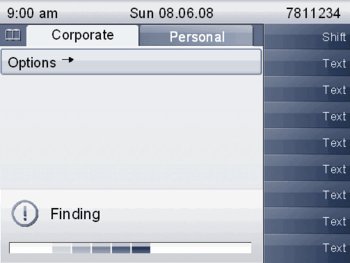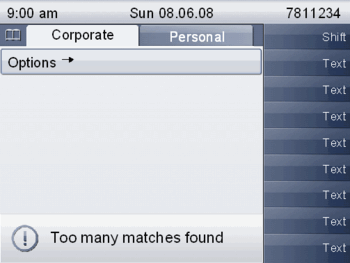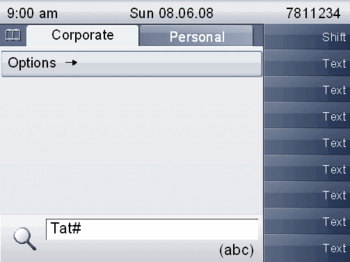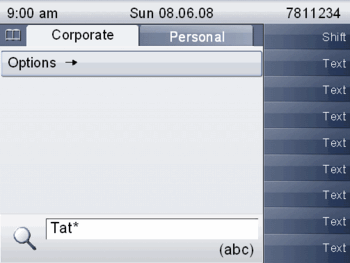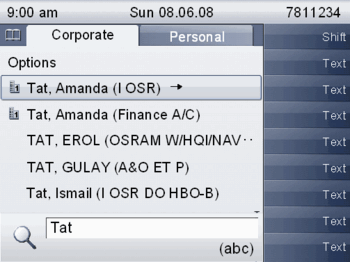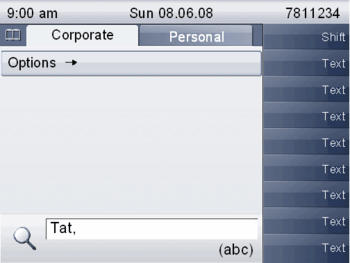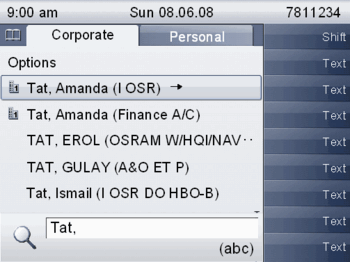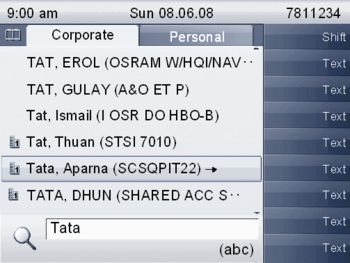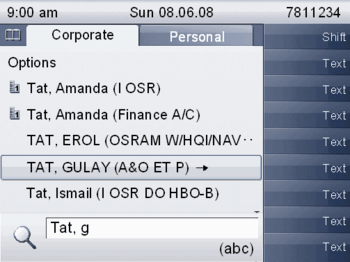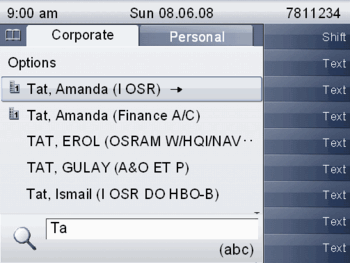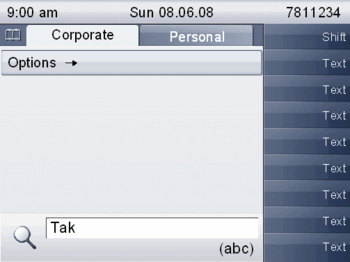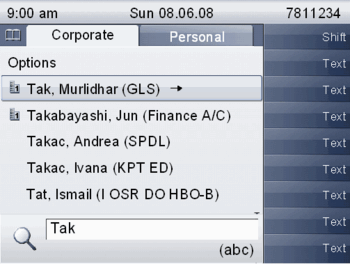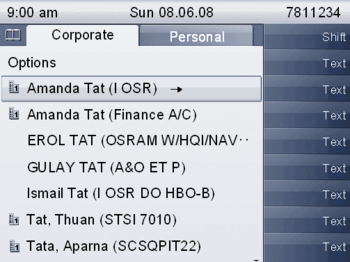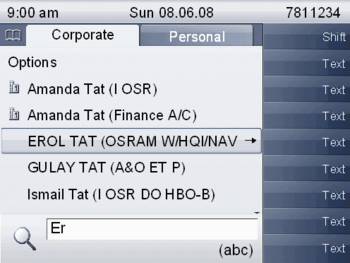Difference between revisions of "LDAP Quick Search"
The Wiki of Unify contains information on clients and devices, communications systems and unified communications. - Unify GmbH & Co. KG is a Trademark Licensee of Siemens AG.
| Line 12: | Line 12: | ||
Below is a collection of screens that may be seen as part of a Simple search action. | Below is a collection of screens that may be seen as part of a Simple search action. | ||
| + | |||
| + | {| style="border-style:none;" | ||
| + | | style="border-style:none;padding-right:10px;" | [[File:LDAP Quick Search Screen 01.gif|350px]] | ||
| + | | style="border-style:none;" | In this screen the Corporate tab is shown with an empty list (i.e. on 1st access to the tab or after the Clear option has been selected for the list). | ||
| + | |- | ||
| + | | style="border-style:none;padding-right:10px;" | [[File:LDAP Quick Search Screen 02.gif|350px]] | ||
| + | | style="border-style:none;" | As the user presses keypad keys the keypad map is displayed as normal to allow the user to select the characters that they want to enter. Since characters have been entered and the list is empty the Simple search triggers are now active. Note that the list screen is still active so the right arrow key will still display the List Options context menu. | ||
| + | |- | ||
| + | | style="border-style:none;padding-right:10px;" | [[File:LDAP Quick Search Screen 03.gif|350px]] | ||
| + | | style="border-style:none;" | Whilst entering characters the user may pause or press the OK key. This will trigger an LDAP search. | ||
| + | |- | ||
| + | | style="border-style:none;padding-right:10px;" | [[File:LDAP Quick Search Screen 04.gif|350px]] | ||
| + | | style="border-style:none;" | The activity popup is shown whenever an LDAP search is triggered and shown over the Quick search popup. The activity popup is automatically removed when the LDAP search result is received or it may be removed by user input. If a valid set of matches are returned then the list will be filled when the activity popup is removed, otherwise the warning popup is displayed. The Quick search popup is left showing and resumes accepting input when the activity popup is removed. | ||
| + | |- | ||
| + | | style="border-style:none;padding-right:10px;" | [[File:LDAP Quick Search Screen 05.gif|350px]] | ||
| + | | style="border-style:none;" | A timed warning popup is displayed when the LDAP search resulted in too many entries. This popup replaces the “Finding” activity popup and the warning popup may also be removed by user input. The Quick search popup is left showing and resumes accepting input when the warning popup is removed The list will be left empty if there are too many matches found by the LDAP server. | ||
| + | |- | ||
| + | | style="border-style:none;padding-right:10px;" | [[File:LDAP Quick Search Screen 06.gif|350px]] | ||
| + | | style="border-style:none;" | The user may enter a hash character to trigger an immediate LDAP search without using a wildcard. The hash character will appear initially in the input box of the Quick search push-up but this will be covered by the “Finding” activity popup when the LDAP search commences. The hash character is removed from the input box so that it is not shown when the Quick search push-up is uncovered. | ||
| + | |- | ||
| + | | style="border-style:none;padding-right:10px;" | [[File:LDAP Quick Search Screen 07.gif|350px]] | ||
| + | | style="border-style:none;" | The user may enter an asterisk character to trigger an immediate LDAP search but still using a wildcard. The asterisk character will appear initially in the input box of the Quick search push-up but this will be covered by the “Finding” activity popup when the LDAP search commences. The asterisk character is removed from the input box so that it is not shown when the Quick search push-up is uncovered. | ||
| + | |- | ||
| + | | style="border-style:none;padding-right:10px;" | [[File:LDAP Quick Search Screen 08.gif|350px]] | ||
| + | | style="border-style:none;" | When the LDAP search has returned valid results the list is shown populated when the “Finding” activity popup is removed. The input box of the Quick search push-up retains the entered characters (less a hash or asterisk character) when it is uncovered provided that the Display setting for the Corporate tab is set to “Last name, First name”. In the screen shown the Qualifier setting has specified an extra attribute to be shown for each list entry. | ||
| + | |- | ||
| + | | style="border-style:none;padding-right:10px;" | [[File:LDAP Quick Search Screen 09.gif|350px]] | ||
| + | | style="border-style:none;" | The user may also enter a comma character to trigger an immediate LDAP search without using a last name wildcard. The comma character will appear in the input box of the Quick search push-up but this will be covered by the “Finding” activity popup when the LDAP search commences. The comma character is retained in the input box and shown (provided that the Display setting for the Corporate tab is set to “Last name, First name”). | ||
| + | |- | ||
| + | | style="border-style:none;padding-right:10px;" | [[File:LDAP Quick Search Screen 10.gif|350px]] | ||
| + | | style="border-style:none;" | When the LDAP search has returned valid results the 1st entry that starts with the same characters that are shown in the input box of the Quick search push-up is highlighted. Normally this will be the 1st entry in the list.This example shows an input box search string terminated by a comma character but the action is the same for whatever the input box contains. | ||
| + | |- | ||
| + | | style="border-style:none;padding-right:10px;" | [[File:LDAP Quick Search Screen 11.gif|350px]] | ||
| + | | style="border-style:none;" | Once the list is populated the Quick search push-up resumes its normal role of highlighting the 1st entry that starts with the same characters that are shown in the input box of the Quick search push-up and the highlight is adjusted each time that the input box changes.Note that the list screen is still active so the right arrow key will still display the highlighted entry’s context menu and the OK key will dial the default destination for the entry. | ||
| + | |- | ||
| + | | style="border-style:none;padding-right:10px;" | [[File:LDAP Quick Search Screen 12.gif|350px]] | ||
| + | | style="border-style:none;" | Another example where the 1st entry that starts with the same characters that are shown in the input box of the Quick search push-up is highlighted as the input box is changed.Note that the list screen is still active so that the up and down keys or the touchwheel may still be used to navigate within the list. However if these mechanisms are used the Quick search popup is removed and its input box is cleared. | ||
| + | |- | ||
| + | | style="border-style:none;padding-right:10px;" | [[File:LDAP Quick Search Screen 13.gif|350px]] | ||
| + | | style="border-style:none;" | Again the highlight moves to the 1st entry that starts with the same characters that are shown in the input box of the Quick search push-up but this time due to a character being deleted. | ||
| + | |- | ||
| + | | style="border-style:none;padding-right:10px;" | [[File:LDAP Quick Search Screen 14.gif|350px]] | ||
| + | | style="border-style:none;" | In this example the input box of the Quick search push-up has been changed from “Ta”, which did match a list entry, to “Tak” which did not match any of the list entries and hence the list is cleared. When the list is cleared the LDAP search triggers are re-engaged. | ||
| + | |- | ||
| + | | style="border-style:none;padding-right:10px;" | [[File:LDAP Quick Search Screen 15.gif|350px]] | ||
| + | | style="border-style:none;" | Here a LDAP search has been triggered and returned a set of valid results which have been displayed in the list.For this example the Display setting for the Corporate tab is set to “Last name, First name” and hence the characters in the input box of the Quick search push-up are retained for subsequent navigation within the list. | ||
| + | |- | ||
| + | | style="border-style:none;padding-right:10px;" | [[File:LDAP Quick Search Screen 16.gif|350px]] | ||
| + | | style="border-style:none;" | If the Display setting for the Corporate tab is not set to “Last name, First name” then the Quick search push-up is not shown when the list is populated with the matched entries. | ||
| + | |- | ||
| + | | style="border-style:none;padding-right:10px;" | [[File:LDAP Quick Search Screen 17.gif|350px]] | ||
| + | | style="border-style:none;" | The Quick search push-up is automatically shown whenever the user presses a keypad key and it resumes its role of navigating within the list. | ||
| + | |} | ||
Revision as of 09:20, 14 April 2010
| Systematics | |
| Family: | OpenStage |
| Model: | OpenStage 60 OpenStage 60 |
| Relation: | {{{relation}}} |
| Release: | V2R0.30.0 |
After selecting the „Corporate“ (LDAP) tab via mode key „phonebooks“ a single-line search window appears at the display, if a search pattern is entered. A search starts after input of the corresponding initial characters after a period of time or after pressing the “OK” key. All available names with the cor-responding initial characters are displayed.
Procedure
Below is a collection of screens that may be seen as part of a Simple search action.

